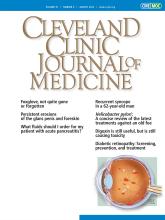Article Figures & Data
Tables
Testing method Pros Cons Cost (approximate) Sensitivity Specificity Invasive tests Endoscopic biopsy Allows direct visualization of H pylori infection
Allows for histological evaluationDiscomfort and risk of complications $$–$$$ 95%–98% 95%–98% Rapid urease test Quick results (usually within minutes)
Relatively low costFalse negatives can occur with recent proton pump inhibitor use or active bleeding $–$$ 90%–95% 95%–98% H pylori culture Allows for antibiotic susceptibility testing Time-consuming and labor-intensive $$–$$$ Variablea Variablea Molecular testing (gastric tissue) High sensitivity and specificity
Can detect resistance mutationsRequires specialized equipment and expertise $$–$$$ 90%–95% 90%–95% Noninvasive tests Stool antigen test Easy to collect specimens May yield false negatives if antigen levels are low $–$$ 90%–95% 90%–95% Molecular testing (stool) Easy to collect specimens
High sensitivity and specificityRequires specialized equipment and expertise $$–$$$ Variable Variable Serology (blood test) Easy to perform Cannot distinguish current infection from past exposure
False positives can occur$–$$ 80%–85% 80%–85% Urea breath test Well tolerated
High sensitivity and specificityRequires abstaining from certain medications (eg, antibiotics, proton pump inhibitors) before the test
False positives can occur in the presence of urease-producing bacteria other than H pylori$$–$$$ 95%–98% 95%–98% GastroPanelb Provides comprehensive information on gastric health Limited availability
Interpretation may be complex$$$ Variable Variable - TABLE 2
Recommended susceptibility-based Helicobacter pylori eradication therapy after failure of empiric therapy
Susceptibility testing results Recommended regimen Clarithromycin-susceptible Clarithromycin triple therapy for 14 days Clarithromycin-resistant, metronidazole-susceptible Metronidazole triple therapy for 14 days Clarithromycin- and metronidazole-resistant, levofloxacin-susceptible Preferred: empiric therapy with bismuth quadruple therapy for 14 days
Alternative: levofloxacin triple therapy for 14 daysa↵a If levofloxacin triple therapy is selected and fails, bismuth quadruple therapy is the next step.
Based on information from reference 15.
Regimen Drug and dosing Duration Empiric therapy Bismuth quadruple therapy Bismuth subsalicylate 300 mg 4 times daily, 30 minutes before meals
Tetracycline 500 mg 4 times daily, 30 minutes after meals
Metronidazole 500 mg 4 times daily, 30 minutes after meals
Proton pump inhibitor (standard dose) twice daily, 30 minutes before meals and at bedtime, or before morning and evening meals14 days Bismuth quadruple therapy (Pylera) Combination pill containing bismuth, tetracycline, and metronidazole 4 times daily with meals and at bedtime
Proton pump inhibitor (standard dose) twice daily, 30 minutes before meals and at bedtime14 days Susceptibility-based therapy Clarithromycin triple therapy Clarithromycin 500 mg twice daily, 30 minutes after meals
Amoxicillin 1 g twice daily, 30 minutes after meals
Proton pump inhibitor (standard dose) twice daily, 30 minutes before meals14 days Metronidazole triple therapy Metronidazole 500 mg twice daily, 30 minutes after meals
Amoxicillin 1 g twice daily, 30 minutes after meals
Proton pump inhibitor (standard dose) 3 times daily, 30 minutes before meals14 days Levofloxacin triple therapy Levofloxacin 500 mg daily, 30 minutes after meal
Amoxicillin 1 g twice daily, 30 minutes after meals
Proton pump inhibitor (standard dose) twice daily, 30 minutes before meals14 days Based on information from reference 15.
- TABLE 4
Proposed approach for Helicobacter pylori eradication therapy incorporating vonoprazan
Preferred regimens Alternative regimens Antimicrobial susceptibility information not available Clarithromycin resistance < 15% Vonoprazan triple therapya Vonoprazan dual therapyb
Clarithromycin triple therapy
Bismuth quadruple therapyClarithromycin resistance ≥ 15% Bismuth quadruple therapy Vonoprazan dual therapyb Antimicrobial susceptibility information available Clarithromycin susceptible Clarithromycin or vonoprazan triple therapya Vonoprazan dual therapyb Metronidazole susceptible Metronidazole triple therapy Vonoprazan dual therapyb Levofloxacin susceptible Levofloxacin triple therapy Vonoprazan dual therapyb
Bismuth quadruple therapy






